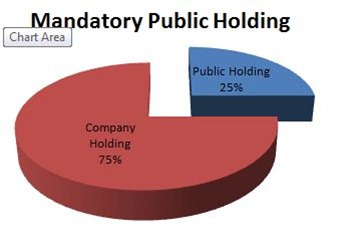Until now, traders and investors in blue-chip stocks based their buying/selling decisions for a particular stock based on fundamentals and/or technical view on the counter.
However, from now on, the frenzy of speculation in these counters could as well be co-related with one more crucial aspect – the public float of the company.

The government has made it mandatory for all listed companies to have a minimum public float of 25%. Already listed companies, where the public shareholding is below the stipulated mark, will get an option to creep to the limits by way of annual addition of at least 5% in public domain.
The new law would have broader ramifications on the structure of the equity holdings of various listed companies, whether government or privately-owned. The promoters of the companies will have to shed more shares in favour of the public holding, where public float is lower than 25%.
HOLD | ||
Disinvestment | ||
in % * | Rs Crore # | |
MMTC | 24.33 | 41470.30 |
NMDC | 23.38 | 44998.63 |
Power Fin.Corpn. | 14.78 | 4102.75 |
NTPC | 14.50 | 24222.69 |
MRPL | 13.57 | 1839.91 |
National Aluminum | 12.15 | 2865.97 |
Power Grid Corpn | 11.36 | 5115.93 |
SAIL | 10.82 | 9188.45 |
Reliance Power | 9.78 | 3320.38 |
Tech Mahindra | 7.97 | 916.07 |
Mundra Port | 6.04 | 1550.68 |
Oracle Fin.Serv. | 5.52 | 1036.39 |
Wipro | 4.61 | 4435.97 |
IOCL | 3.92 | 2983.76 |
DLF | 3.64 | 1896.81 |
Tata Tele. Mah. | 2.73 | 125.34 |
Tata Comm | 1.15 | 99.59 |
Bharat Electron | 0.86 | 135.77 |
Total | 150305.39 | |
* The extent to which total promoter holdings needs to be reduced to ensure a minimum 25% of public holding | ||
Ramification on IPOs
Companies looking to tap the IPO market to raise funds from the investors will also have to abide by this new law. That’s not all, even equity placements to institutional investors will be excluded from being a part of the public float.
This would mean that companies coming out with fresh public issues will have to announce higher stakes for the portion reserved for the retail investors or ensure dilution of promoter equity by 5% annually over the next few years until 25% public float level is reached.
Queue for De-listing Likely
It is believed that most of MNC listed companies in India are the most reluctant of the lot to dilute their shareholding in the public domain than what is already there.
Apart from that, there are some private companies where the promoters hold a majority portion of the stake whereas the general public own less than 5% stake. Such companies where promoters are reluctant to further dilute their stake to meet the new norms, could lead them to buy-out the remaining public stake in the market and get de-listed from the bourses.
For example, Micro Inks came out with delisting offer few months back. General public hold only 4.61% stake as on March 2010. In short, many such delisting offers could crop-up, within next few years, where promoters are not be willing to dilute their stake further.
An Automatic Disinvestment Mandate for the Centre
With the announcement of this new law, arrives a mandate for the state-owned listed firms with lower public shareholding, to meet the higher divestment targets in confirmation with the new 25% public float rule.
Take, for example, state-owned MMTC and NMDC. General public stake in both the companies is limited to the extent of 0.03% and 0.72%, leaving a room for large amount of disinvestments to be carried out in such PSU firms.
Other large PSU companies such as Power Grid Corporation, PFC, NTPC and SAIL need to divest anywhere between 10-15% depending upon their current status of public float.
What’s in for Investors?
Specifically, for investors it would mean over-all higher stake in both government and private companies. This would translate into lower promoter stake and higher visibility for the company by enhanced public stake and participation.
For government-owned companies, it would mean deeper scrutiny into the operations and policies of the company and, most of all, speedy implementation of the projects triggered by higher transparency. The over-all Indian equity markets would be a better place to invest with higher public say in the management of the listed companies.
The new rules also strengthens the market in the way that higher public float would mean lesser room for manipulation by a few big traders and other financial institutions who have capability to jack-up stock prices on the back of lower volumes on the bourses.
All-in-all, the new rule could well prove out to be an investor-friendly measure and improving the valuations of the company by a strong support from retail investors.

No comments:
Post a Comment